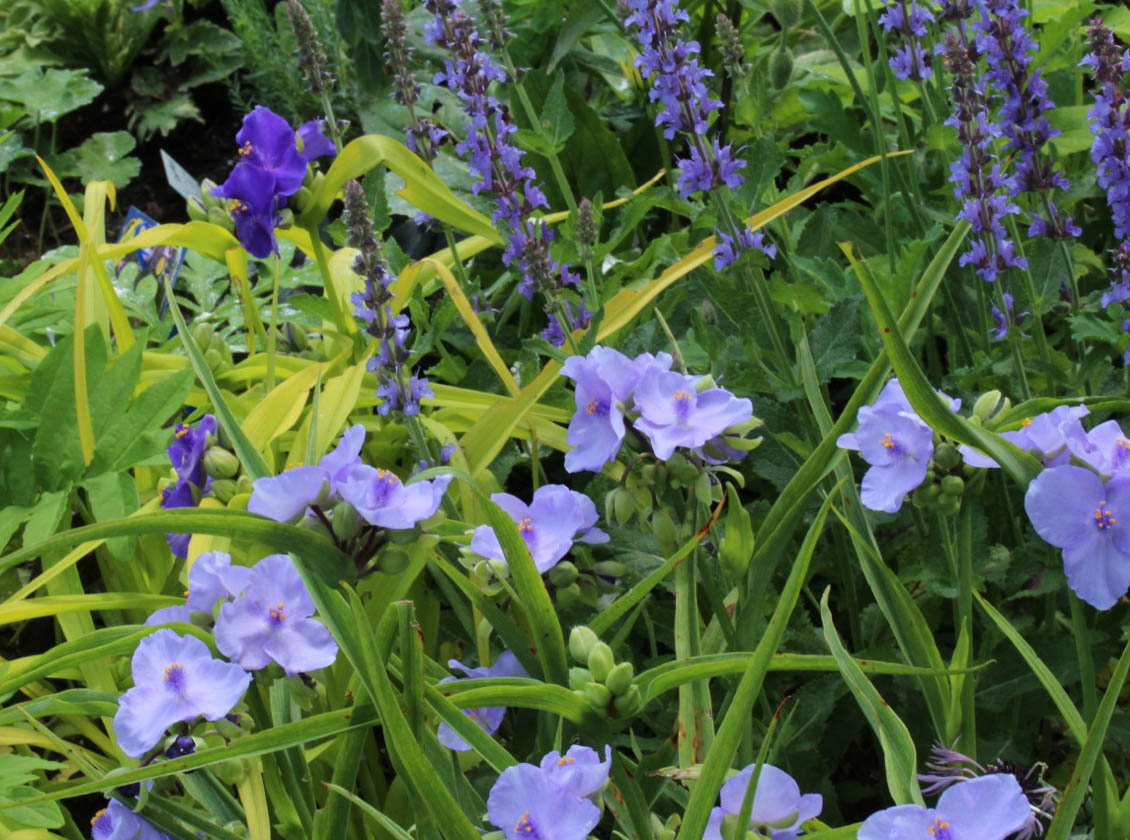One of the great joys of gardening, of course, is the chance to play with colour. It's like painting with plants: you get to create wonderful colour combinations that please your eye, and that can be changed up yearly, or by moving a couple of container plantings around.
We all have particular colours that please us, or that we use a lot of in a garden planting. Myself, I am fond of pretty much all colours in the garden, but I have made a dedicated effort this year to creating drifts of colours. I'm doing this for several reasons.
In the first place, we get more visual bang for our buck if we plant similar coloured flowers together. In this photo, there are three blue-flowered plants: Chinese forgetmenots, (Cynoglossum), 'Chattahootchee' woodland phlox, and 'Blue Ice' amsonia. They all have fairly small flowers, although quite a lot of flowers, and bloom at the same time, so I get a nice cooling drift of blue in one section of the garden.
In the second place, pollinators can see drifts of one colour more easily than they can see a polka dot arrangement of colours, so I am planting in drifts to help them find my garden of food sources. I'm all about the pollinators, and have been for years.
Maybe my favourite colour echo was sort of an accident. I had bought three Love them and leave them plants: Beaujolais lysimachia, Chocolate cosmos, and a striking little non-hardy black Scabiosa, and tucked them all into a well-drained area. Then I was given a clump of Mourning Widow cranesbill as a passalong plant by a friend--from a clump I gave her several years ago, before I left my former garden--and I picked up gorgeous chocolate-coloured Salpiglossis, and the result was a strikingly different, dark-flowered planting.
This orange-yellow grouping is young yet: a perennial orange poppy, Echinacea 'Evening Glow', which changes colour as the flowers age, and Primula bulleyana, one of the candlestick primroses. With the Amsonia tabernaemontana is the centre it isn't the best colour grouping, but the amsonia is now finished flowering while the other three are still going strong.
Some pairings or combinations are happy accidents, as when this honeysuckle (which I am pretty sure is Mandarin) landed in the middle of a planting of annual sage...
Others are more intentional. I have a deep fondness for shades of purple and blue and rose, with obvious results in my container plantings.
And this was intentional: Silene 'Fireflies' and its related rose campion (Lychnis coronaria) are both vibrating in hot fuchsia pink. These are planted beside the chocolate grouping, so they tend to temper each other a little.I've made an effort this year to plant more white flowers, in part because they really do show up in soft morning or dusk light. They also tend to cool off a planting somewhat. I have a fondness for alliums (top left) but also for spiky flower heads. Clockwise from top right, White Angelonia (annual), 'Husker Red' penstemon's white flowers, and delphinium 'White with black bee'.
And because we can never have too many purple flowers--in different shades of purple, too!--one final purple combination, including 'Sweet Kate' tradescantia (gold foliage), a pale lavender one, the name of which escapes me, and a deep purple perennial sage, which I've also misplaced the name of. Despite best efforts, nametags do go missing, especially when left in the garden all season!
I have other colour echoes going on, but these are enough for today. What about you--do you plant in drifts of colour?











You have some pretty spectacular combinations in your garden. Like you, I added some white areas to cool our hot climate the least bit. I agree there can't be too much purple.
ReplyDelete